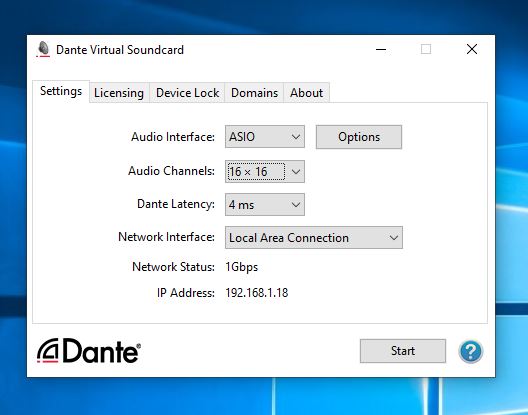

- Using dante virtual soundcard update#
- Using dante virtual soundcard driver#
- Using dante virtual soundcard software#
- Using dante virtual soundcard professional#

Further more, it is capable of aggregating all USB/Firewire interfaces connected to a computer and make all their ins and outs accessible on the entire Dante network in addition to the "regular" Dante channels it also provides. It just works.ĭante Via is similar to DVS, however, it is capable of providing Dante-PTP-clocking for an entire network. In my setup, there are over 150 audio channels constantly running between multiple devices and booths in the background at all times! I don't even think about it. No issues at all even when streaming several HD videos on youtube simultaneously while doing a large audio mix over the network. My internet router is also connected (DHCP server). In my config, I have a digital console (Ymaha DM1000), a computer fitted with a 128-in/out-channel Dante PCIe card, a Dante-enabled converter (Ferrofish A32 Dante) and a laptop running DVS connected via 2 Cisco SG200-08 manageable gigabit switches via cat6a cables. For smaller networks (below 25 Dante peers) it is not required to configure QoS, however QoS will ensure that IP audio packets and especially PTP-based Dante clocking will be prioritized. It is important to turn off any "green ethernet" and energy saving functionality which could lead to unwanted data throttling and thus may risk audio drop-outs. Regarding switches, you'll need a standard manageable gigabit switch. However, you can connect multiple computers running Dante Via OR multiple computers running DVS and one Computer running Dante Via as Dante Via does have clocking master capabilities.
Using dante virtual soundcard software#
You cannot connect two or even more computers only by running DVS on them because DVS requires at least one Dante hardware device or another computer running Dante Via software present on the network to be properly clocked. Obviously, you need another Dante-enabled device at the other end of the ethernet cable.
Using dante virtual soundcard driver#
Dante Virtual Soundcard (DVS) is a device driver that turns the NIC port of your Mac or PC into a 64圆4 in/out ASIO/WDM audio interface. ‘We want to ensure using virtualised environments get the same reliable high performance that has made Dante Virtual Soundcard the workhorse of the audio industry.’ĭante Virtual Soundcard with support for installation on virtual machines is available from Audinate in multi-activation licence editions only, and cannot be purchased from the Audinate web store.I have an entirely Dante-based studio consisting of Dante-enabled audio hardware and Dante Virtual Soundcard since 2014 and tested multiple configurations over time.
Using dante virtual soundcard professional#
‘Dante Virtual Soundcard is already the gold standard for professional recording and playback on thousands of networks around the world,’ says Senior Product Manager, Nick Mariette. Dante Virtual Soundcard is an ideal solution for computer-driven media playback, multichannel recording and lecture capture, and is fully compatible with the more than 2,000 Dante-enabled products available from multiple vendors.

Turning any computer into a Dante endpoint for networked audio, Dante Virtual Soundcard provides a standard WDM or ASIO audio interface that allows any installed audio software to send and receive up to 64 channels of lossless audio over a standard 1Gbps network to any Dante-enabled A/V endpoints, including other instances of Dante Virtual Soundcard.
Using dante virtual soundcard update#
This update targerts broadcasters, educators and corporate users wishing to use Dante networked audio throughout data centres, studios, server clusters and campuses.ĭante Virtual Soundcard interfaces directly with audio software running on virtual machines, allowing distribution of media playback and centralised recording. Audinate has announced the availability of Dante Virtual Soundcard for installation in virtual Windows environments using Type-1 hypervisors.


 0 kommentar(er)
0 kommentar(er)
